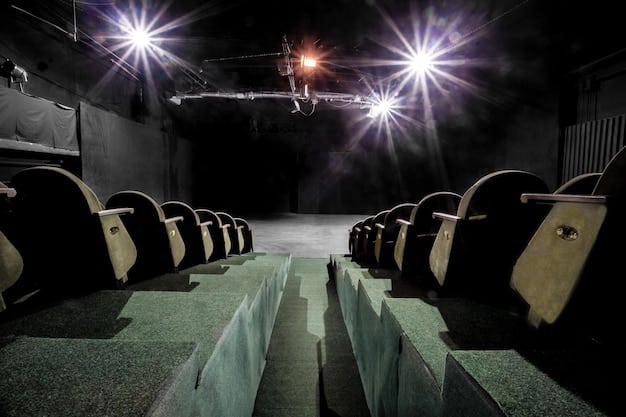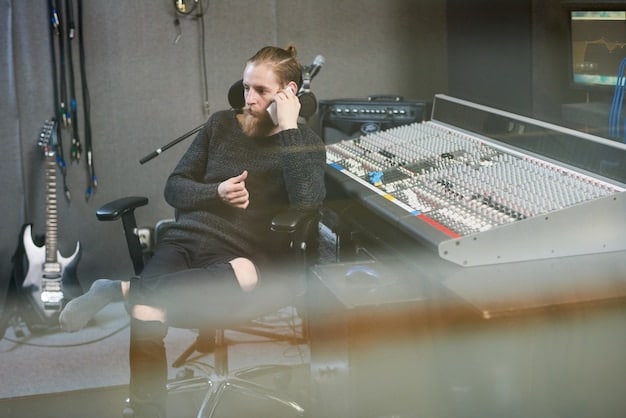The Sound of Silence: Audio’s Emotional Impact on Movie Finales

Sound designers reveal how the strategic use of silence and audio enhancements elevates the emotional resonance of film finales, creating a profound impact on audiences.
Ever wondered why some movie finales leave you breathless while others fall flat? The secret often lies not just in the visuals, but in the artful manipulation of sound. Let’s explore how sound designers use The Sound of Silence: Sound Designers Explain How Audio Enhances Emotional Impact in Finales.
The Power of Sound in Cinematic Storytelling
Sound is more than just background noise in films; it’s a crucial element that drives the narrative and amplifies emotions. From subtle ambient sounds to dramatic musical scores, audio is carefully crafted to immerse you deeper into the story and character arcs.
Think about your favorite movie scenes. Chances are, the sound design played a significant role in how those moments resonated with you. It’s the sound designer’s job to ensure that every auditory detail works to enhance your experience.
Creating Atmosphere with Sound
Sound designers use a variety of techniques to build atmosphere. This can involve layering different sound effects, manipulating pitch and tone, and employing silence to heighten tension. Ambient sounds, like wind or traffic, can set the scene and provide a sense of realism.
- Layering: Combining multiple sounds to create a richer, more complex soundscape.
- Pitch Manipulation: Altering the pitch of sounds to evoke certain emotions or create a sense of unease.
- Strategic Silence: Using silence to emphasize key moments and create suspense.
Ultimately, the goal is to create an auditory environment that supports the visual narrative and enhances the emotional impact.

The Art of Silence: When Less is More
In the world of sound design, sometimes the most powerful tool is not what you hear, but what you don’t. Silence, when used strategically, can amplify tension, create suspense, and evoke a sense of profound loss or realization.
Consider a scene where a character is facing a difficult decision. The absence of music or background noise can draw the audience’s attention to the character’s internal struggle, making the moment more intimate and impactful.
Building Tension with Quiet
Silence is particularly effective in building tension. By abruptly cutting off sound, filmmakers can create a sense of unease and anticipation. This technique is often used in horror and suspense films to heighten the stakes and keep you on the edge of your seat.
Silence can also be used to emphasize key moments, such as a character’s death or a major plot twist. By stripping away all sound, the filmmakers force you to focus on the visual elements and the emotional impact of the event.
The clever use of silence allows filmmakers to engage with audiences more affectively.
Emotional Crescendo: Building to the Finale
The finale of a film is where all the emotional threads come together, and sound designers play a crucial role in ensuring that the climax resonates deeply with the audience. By carefully controlling the sound, they can build tension, amplify emotions, and create a lasting impression.
This involves a meticulous layering of sound effects, music, and dialogue to create a powerful auditory experience that complements the visual narrative and enhances the emotional impact of the final scenes.
Sound Design and Film Score
Music is an essential part of the emotional crescendo. Composers and sound designers work closely together to create a score that supports the narrative and amplifies the emotional impact. The music often builds in intensity as the film approaches its climax, reaching a peak during the final scene.
- Theme Reinforcement: Using musical themes to reinforce emotional connections and character arcs.
- Tempo and Dynamics: Adjusting the tempo and dynamics of the music to build tension or create a sense of euphoria.
- Orchestration: Employing different instruments and arrangements to evoke specific emotions.
The collaboration between sound design and film score is essential for creating a cohesive and emotionally resonant finale.

Case Studies: Iconic Finales and Their Sound Design
Analyzing specific examples of acclaimed film endings can shed light on the subtle but substantial influence of sound. By examining how sound design was employed in these scenes, we can gain a better understanding of its impact on the audience’s emotional experience.
From intense action sequences to quiet, contemplative moments, sound design plays a crucial role in shaping the final impression of a film.
*Inception* (2010)
The ambiguous ending of *Inception*, where the spinning top teeters between reality and dream, is a masterclass in sound design. The subtle shift in the top’s sound, combined with the absence of a definitive resolution, leaves audiences questioning what they’ve just witnessed.
The music in the ending is also very powerful. The tension builds with the music, and then ends abruptly at the end credits – never giving one an audible resolution showing if he’s in reality or still dreaming.
*The Lion King* (1994)
The triumphant score as Simba takes his place on Pride Rock is a classic example of using music to evoke a sense of victory and hope. The combination of soaring melodies and powerful instrumentation creates an emotionally uplifting experience.
It is arguably one of the most iconic scenes using both score and sound design in any film. It signifies the completion of the heroe’s journey and brings the film to a satisfying end.
The Evolution of Sound Design Technology
The tools and technologies available to sound designers have evolved significantly over the years. From analog recording techniques to advanced digital audio workstations, sound designers now have a wide range of options for manipulating and creating sound.
This technological progress has not only expanded the creative possibilities but also allowed for more precise and nuanced audio design, leading to more immersive and emotionally impactful cinematic experiences.
Advancements in Audio Workstations
Digital Audio Workstations (DAWs) have revolutionized sound design. These software programs provide a comprehensive set of tools for recording, editing, mixing, and mastering audio. DAWs also allow sound designers to experiment with different effects and techniques in a non-destructive environment.
- Non-Linear Editing: Allowing for greater flexibility and control over the editing process.
- Real-Time Effects Processing: Enabling sound designers to apply effects and make adjustments on the fly.
- Collaboration Tools: Facilitating remote collaboration and file sharing among sound designers and composers.
The introduction of DAWs has transformed the way sound designers work, making the process more efficient and creative.
Future Trends in Sound Design
As technology continues to advance, sound design will undoubtedly continue to evolve. Emerging trends like spatial audio and immersive soundscapes are pushing the boundaries of what’s possible in cinematic storytelling.
These innovations promise to create even more emotionally engaging and immersive experiences for moviegoers, blurring the lines between reality and fiction.
The Rise of Spatial Audio
Spatial audio, also known as 3D audio, is an emerging technology that creates a more realistic and immersive sound experience. By using multiple speakers or headphones, spatial audio can simulate the way sound travels in the real world, creating a sense of depth and directionality.
The use of spatial audio can make audiences feel more present in the film.
| Key Point | Brief Description |
|---|---|
| 🎵 Sound Design | Crafts auditory elements to enhance narrative and emotion. |
| 🤫 Strategic Silence | Boosts tension and highlights critical moments. |
| 🎬 Iconic Finales | Sound elevates climaxes, shaping lasting impressions. |
| 🎧 Audio Tech | Spatial audio creates immersive experiences. |
FAQ
▼
A sound designer is responsible for creating the overall soundscape of a film, including sound effects, ambience, and dialogue. They work to enhance the story and evoke emotions through audio.
▼
Silence can build tension, draw attention to key moments, and emphasize emotional impact. It can create a sense of unease, anticipation, or profound loss, making certain scenes more impactful.
▼
Films like *Inception*, *The Lion King*, and *Gravity* are known for their exceptional sound design. These films demonstrate how sound can enhance storytelling and emotional resonance.
▼
Sound design technology has advanced from analog recording to digital audio workstations (DAWs). DAWs offer comprehensive tools for recording, editing, and mixing, enhancing creative possibilities.
▼
Future trends include spatial audio and immersive soundscapes, which aim to create more realistic and emotionally engaging experiences. These innovations blur the lines between reality and fiction for viewers.
Conclusion
The art of sound design greatly influences the emotional effect of movie endings. This article has highlighted how careful use of sound elements, silence, and technical developments contribute to producing impactful and memorable cinematic moments. By understanding how sound designers function, moviegoers can develop an improved appreciation for the subtle yet profound influence of audio to storytelling.





